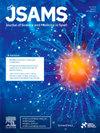Patients follow four clusters of participation in physical exercise after an ACL injury. Results from the NACOX cohort study
IF 3
2区 医学
Q1 SPORT SCIENCES
引用次数: 0
Abstract
Objectives
To explore how participation in physical exercise (PE) changes over time after an anterior cruciate ligament (ACL) injury. Additionally, to identify factors associated with participation in PE by analyzing longitudinal data.
Design
An explorative analysis of the NACOX study, a prospective multicenter cohort study.
Methods
Patients with an acute ACL injury aged 15–40 years were followed for three years. The patients regularly reported participation in PE, knee function, new injuries, and surgeries. State sequence analysis and Hierarchical Cluster Analysis were used to analyze participation in PE. Clusters were compared using an analysis of variances, the Chi-square test, and Fischer's exact test.
Results
The study included 275 patients, 52 % female, with a mean age of 25 years. Four clusters were identified, varying from low to high participation in PE after an ACL injury. Clusters differed regarding the number of ACL reconstructions (ACLR) (p = 0.03); time from injury to ACLR (p = 0.03); patient-reported knee function at the follow-ups at 3 months (p = 0.02), 6 months (p = 0.02), and 12 months (p = 0.02) after injury; PE level before injury (p < 0.001); and number of new injuries and surgeries (other than ACLR) (p = 0.001).
Conclusions
Four clusters, varying from low to high participation in PE after an ACL injury were identified. The results provide valuable insight into factors associated with different levels of participation in PE, which can be helpful for healthcare personnel working with ACL rehabilitation.
前交叉韧带损伤后参加体育锻炼的患者分为四组。NACOX队列研究的结果。
目的探讨前十字韧带(ACL)损伤后,参加体育锻炼(PE)的情况会随着时间的推移发生怎样的变化。此外,通过分析纵向数据,确定参与体育锻炼的相关因素:设计:对NACOX研究(一项前瞻性多中心队列研究)进行探索性分析:方法:对 15-40 岁的急性前交叉韧带损伤患者进行为期三年的随访。患者定期报告参加体育锻炼的情况、膝关节功能、新伤和手术情况。采用状态序列分析和层次聚类分析来分析参与体育锻炼的情况。使用方差分析、卡方检验和费舍尔精确检验对聚类进行比较:研究共纳入 275 名患者,其中 52% 为女性,平均年龄为 25 岁。前交叉韧带损伤后参加体育锻炼的人数从少到多不等,共分为四组。各群组在以下方面存在差异:前交叉韧带重建(ACLR)的次数(P = 0.03);从受伤到 ACLR 的时间(P = 0.03);受伤后 3 个月(P = 0.02)、6 个月(P = 0.02)和 12 个月(P = 0.02)随访时患者报告的膝关节功能;受伤前的体育锻炼水平(P 结论:前交叉韧带损伤后参加体育锻炼的人数从少到多不等:前交叉韧带损伤后参与体育锻炼的程度从低到高分为四组。这些结果为了解与不同程度参与体育运动相关的因素提供了有价值的见解,对从事前交叉韧带康复工作的医护人员很有帮助。
本文章由计算机程序翻译,如有差异,请以英文原文为准。
求助全文
约1分钟内获得全文
求助全文
来源期刊
CiteScore
7.40
自引率
10.00%
发文量
198
审稿时长
48 days
期刊介绍:
The Journal of Science and Medicine in Sport is the official journal of Sports Medicine Australia (SMA) and is an an international refereed research publication covering all aspects of sport science and medicine.
The Journal considers for publication Original research and Review papers in the sub-disciplines relating generally to the broad sports medicine and sports science fields: sports medicine, sports injury (including injury epidemiology and injury prevention), physiotherapy, podiatry, physical activity and health, sports science, biomechanics, exercise physiology, motor control and learning, sport and exercise psychology, sports nutrition, public health (as relevant to sport and exercise), and rehabilitation and injury management. Manuscripts with an interdisciplinary perspective with specific applications to sport and exercise and its interaction with health will also be considered.

 求助内容:
求助内容: 应助结果提醒方式:
应助结果提醒方式:


